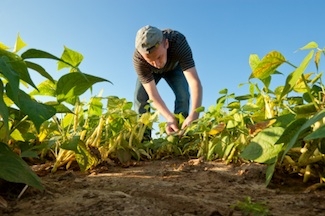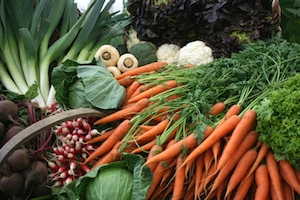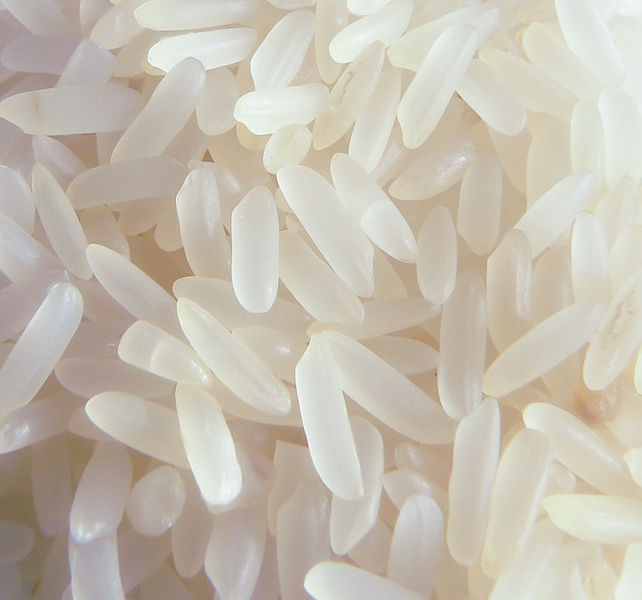UC Food and Agriculture Blogs
Super ways to eat healthy on game day
Super Bowl Sunday is one of the biggest eating days of the year — right up there with Thanksgiving.
Enjoy the party without over indulging. Here's how:
Pre-game warm-up: Eat a healthy breakfast and lunch or snack before you head to the party. Skipping meals to “save up” your calories for the big event backfires when you over eat because you are so hungry.
Think like a winner: Focus on the game and enjoying your friends, rather than on the food.
Have a game plan: Take a look at the food spread before digging in. You don't have to eat some of everything — choose 2 to 3 foods you really like — maybe something you seldom eat (you can eat chips anytime). Take small servings then fill up your plate with healthy items like fruit and veggies (but go easy on the dip — just 1 tablespoon typically has a 100+ calories!)
Follow a winning strategy: Eat mindfully — think before you put something in your mouth. After serving your plate, move away from the buffet table where it's easy to eat lots of guacamole and chips (without even thinking about it) while you're standing there watching the game.
Take a break at half-time: Grab a friend or two and take a walk in the neighborhood. You'll gain energy and be ready to tackle the second half of the party.
Keep advancing toward the goal line: Regular soda, lemonade, beer and cocktails can add lots of extra calories. Drink light versions of your favorite beverages. If you indulge in cocktails, limit the calories by limiting yourself to two drinks — one each half, and drink water the rest of the time.
Avoid time-outs: Don't let food-borne illness ruin your game. Avoid eating perishable foods that have been left out at room temperature for more than two hours. That includes things like chicken wings, nachos with chicken or beef, barbeque sliders, dips made with sour cream, and cut fruits and vegetables (unless served on ice).
Score the winning touchdown! Make healthy choices and have a great time.
How do you put on a Super Bowl spread that's healthier for your family?
Beyond manifesto: How to change the food system
Mark Bittman, cookbook author and New York Times food writer, used the occasion of New Year’s Day to throw down the gauntlet for real and permanent change to the U.S. agricultural system. “We must figure out a way to un-invent this food system,” he says in a Times opinion column. He likens the scale of the task to tectonic cultural strides like abolition, civil rights, and the women’s vote.
As to how we go about achieving this goal, Bittman speaks in broad terms. He appeals for patience, invoking the pioneers of those transformative movements, who had the perspective that their progress is not just for now but for future generations. He names the culprits of sugary drinks and poor livestock conditions as key points of attack. He calls for goals. Well reasoned approaches, to be sure, but they aren’t a blueprint for specific action.
UC Berkeley researchers have been working on some specifics for several years now, researching the agricultural, policy, and social practices that would make possible the type of systemic change Bittman is advocating. In a special multi-article feature devoted to "diversified farming systems," or DFS, for the December issue of the journal Ecology & Society, scientists from Berkeley, Santa Clara University, and other institutions lay out a comprehensive scientific case that biologically diversified agricultural practices can contribute substantially to food production while creating far fewer environmental harms than industrialized, conventional monoculture agriculture—that is, large swaths of land devoted to growing single crops using chemical inputs.
DFS are different from the narrow definition of organics, and the research shows that, unlike industrial agriculture, biologically diversified agriculture tends to generate and regenerate ecosystem services such as soil fertility, pest and disease control, water-use efficiency, and pollination, which provide critical inputs to agriculture. The research also found that DFS support globally important ecosystem services, including substantially greater biodiversity, carbon sequestration, energy-use efficiency, and resilience to climate change.
But changing America’s agriculture system is more complex than just changing farming techniques, according to Alastair Iles, assistant professor of environmental science, policy, and management, and co-director of the Berkeley Center for Diversified Farming Systems.
“If diversified farming systems are to thrive in the United States, policies and preferences must evolve to reward the environmental and social benefits of sustainable farming and landscape management,” Iles says. “Policies supporting ecological diversification are underdeveloped and fragmented compared with conventional agricultural policies.”
In one Ecology & Society article, Iles and co-author Robin Marsh, also of UC Berkeley, consider several obstacles that prevent or slow the spread of diversified farming practices, such as the broader political and economic context of industrialized agriculture, the erosion of farmer knowledge and capacity, and supply chain and marketing conditions that limit the ability of farmers to adopt sustainable practices.
“To transform agriculture, we need to understand these obstacles and develop and test solutions, such as peer-to-peer learning, recruitment and retention of new farmers through access to credit and land, and compensation for ecological services provided by ranchers, for example,” Iles says.
Other key facets of a sustainable agricultural system include attention to its social dimensions, such as human health, labor, democratic participation, resiliency, diversity, equality, and ethics, according to special issue co-editor Chris Bacon of Santa Clara University. In an article with colleagues, Bacon proposes creating partnerships with institutions that could address issues like immigration, food access, and worker health.
But first and foremost, the farms themselves have to produce enough to remain profitable and to feed a growing population. Conservation biologist Claire Kremen, also a UC Berkeley professor and co-director of the Berkeley DFS Center with Iles, says that more work is needed to build on what is already known about biologically diversified agriculture, to make them these methods even more productive.
“To date, the amount of research and development investment in this type of agriculture is miniscule compared to what’s been invested in conventional agriculture,” Kremen said. “There may be substantial potential to increase food production from biologically diversified, sustainable agriculture that we have not yet tapped into. With research support to study and improve on sustainable farming systems, we can tap that potential. Growers want to utilize sustainable practices if they can, but they need to know it won’t hurt their bottom line.”
So, DFS scientists might argue, Bittman’s New Year’s manifesto, which ends with a call for “energy, action — and patience,” could be amended to include “a comprehensive scientific, political, and sociological approach, and putting dollars behind the right kinds of research.”
Read more about diversified farming systems research at UC Berkeley.
Nominate a farmer or an educator for a Pedro Ilic Award
Calling all small-scale farmers and their supporters! Now is the season of awards and conferences in the agricultural world — and that goes for small-scale farmers too. At the moment, we are seeking nominations for the Pedro Ilic Awards, which honor dedication to small-scale farming.
These awards are named for Pedro Ilic, Fresno County small-scale farm advisor, whose death in 1994 prompted the UC Small Farm Program to annually honor those who carry out his legacy of personal commitment to small-scale and family farming. Ilic was one of the original advisors when the Small Farm Program was established in 1979.
Each year, the awards honor an educator and a farmer who embody characteristics that helped make Ilic a success.
Anyone can write a nomination. Take a look at the nomination form, which is now online. The deadline for nominations is February 4.
The awards will be presented at the California Small Farm Conference, March 10-12 in Fresno.
This conference, which rotates location each year, is the state's premier gathering of small farmers, agricultural students, farmers market managers and others involved in the small-farm industry. The three-day educational conference includes day-long short courses and on-farm tours; 25 focused workshops; keynote addresses and many networking opportunities.
Do you know an outstanding farmer or agricultural educator? Honor him or her with a nomination for the Pedro Ilic Award!
'Tis the season to balance food with physical activity
For years the news and media have released reports that the holidays mean weight gain and ever-widening waistlines. All the hype leaves me asking: how many holidays between Thanksgiving and New Year’s do we actually have?
Ok, so take out your calendar and circle the holidays and potential “food-related” events you might attend. We have Thanksgiving Day, Hanukkah, Christmas Day, Kwanzaa, New Year’s Eve, and a Saturday or two of holiday parties to attend. When we look at it that way, it becomes more and more clear to us that Thanksgiving isn’t our ticket to eat foods laden with fat throughout the month of December! What it does do, however, is remind us of the food related events to come.
There are a few things in life that that we just can’t control: holiday gatherings, office Christmas parties, laughing at a not-so-funny joke, and, did I mention, family? Let’s face it, as much as we would like to control the holiday season, there are times when we just can’t.
What’s completely within our control? Physical activity! I know, I know, the moment I say physical activity we start thinking of the closet of winter clothes we need to organize, the windows that need to be washed (even though it’s going to rain tomorrow), or the dusting that you just haven’t been able to get to all summer (maybe that’s just me).
But if we know that the next month or so is going to be filled with food-related activities, why not counter-balance the darts of despair with shields of activity? Because that my friend, we can control!
Increasing physical activity provides the body and mind with many benefits:
- Increase your chances of living longer
- Feel better about yourself
- Decrease your chances of becoming depressed
- Sleep well at night
- Move around more easily
- Have stronger muscles and bones
- Stay at or get to a healthy weight
- Be with friends or meet new people
- Enjoy yourself and have fun
Why should I move more? According to the USDA guidelines, when we are not physically active, we increase our chances of:
- Heart disease
- Type 2 diabetes
- High blood pressure
- High blood cholesterol
- Stroke
Physical activity can divided into four different types:
- Aerobic activities: this activity can be moderate or vigorous (running, walking, skating)
- Muscle-strengthening activities: makes your muscles stronger (weight lifting, push-ups)
- Bone-strengthening activities: make your bones stronger (jumping)
- Balance and stretching activities: enhance physical stability and flexibility (yoga, dancing, t’ai chi)
So what’s your type? Do you like vigorous or moderate exercise? Don’t be afraid to get creative! Physical activity is simply movement of the body that uses energy. Find more ways to increase your physical activity at home, work, and play by visiting Choosemyplate.gov
This holiday season, lets focus on the parts of the holiday season we can control.
Why wait for New Year’s to start gaining the benefits of physical activity?
No need to be concerned about eating rice and rice products
A UC Cooperative Extension specialist says there isn’t enough scientific evidence to warrant consumers making changes to their diets nor to their children’s diets based on recent media reports about levels of arsenic in rice. The issue arose from an analysis by Consumer Reports of white and brown rice from around the world and rice products like rice cereal, rice milk and rice pasta.
“In virtually every (rice) product we tested, we found measurable amounts of total arsenic,” said the article.
However, Carl Winter, UC Cooperative Extension specialist in the Department of Nutrition at UC Davis, said it’s too early to recommend any changes in diet because of these findings.
“Arsenic is a naturally occurring element, found in a lot of different foods and some drinking water at different levels,” Winter said. “We’ve been consuming it all our lives. It’s too early to say whether it is causing any harm.”
He suggests people continue to eat a balanced diet that includes a wide variety of foods while the federal officials who are charged with protecting the United States’ food supply draw scientific conclusions about dietary arsenic exposure.
The U.S. Food and Drug Administration is currently collecting thousands of samples of rice-containing foods to develop a database that will allow the agency to establish acceptable levels in foods. Preliminary data released by the FDA in September found that the average levels of inorganic arsenic to be 3.5 to 6.7 micrograms per serving. The data collection is expected to be completed by the end of the year.
“The scientific approach is being taken right now to get a real handle on the typical level people consume,” Winter said. “Before you do that, it’s hard to say any population is at risk.”
Arsenic may be present in some other foods, but most crops don’t readily take up much arsenic from the ground. Rice is different because it is grown in flooded conditions. In an anaerobic environment, arsenic changes into a form that is easier for plants to absorb.









